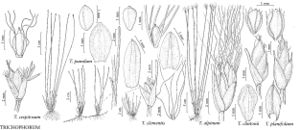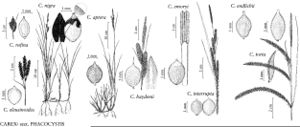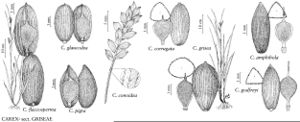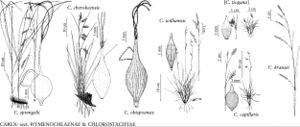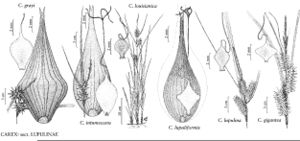Cyperaceae
Herbs, annual or perennial, cespitose or not, rhizomatous or not, stoloniferous or not. Roots fibrous, principally adventitious. Stems (culms) usually trigonous, occasionally terete, rarely compressed, usually solid, rarely hollow or septate. Leaves basal and/or cauline, alternate, usually 3-ranked, rarely 2-ranked or multi-ranked, bases forming cylindric sheaths enclosing stem, margins usually fused; junction of sheaths and blades often with adaxial flaps of tissue or fringes of hair (ligules); blades frequently absent from some basal leaves, rarely from cauline leaves, when present divergent or ascending, flat, folded, plicate, rolled, or terete, linear, venation parallel. Primary inflorescences (spikelets) a shortened axis; glumaceous bracts (scales) 1–many, spirally arranged, sometimes 2-ranked, usually appressed or ascending; scales usually all fertile, each subtending a single flower, sometimes proximal and/or distal scales empty; lateral spikes often with basal, usually empty, usually 2-keeled scale (prophyll); occasionally prophyll subtending and enclosing rachilla, bearing 1 pistillate, sometimes (0–) 3 staminate flowers and empty scales (Carex, Cymophyllus, and Kobresia). Secondary inflorescences panicles, often modified to corymb, pseudoumbel, cyme (anthela), raceme, spike, or capitulum (head), rarely single spike, usually subtended by foliaceous or, less frequently, glumaceous bracts; secondary inflorescences sometimes simulating spikelets (Carex, Cymophyllus, and Kobresia). Flowers hypogynous, bisexual in most genera, unisexual in Scleria, Carex, Cymophyllus, and Kobresia; perianth absent or with (1–) 3–6 (–30) bristles and/or scales, usually falling off with fruit; stamens usually (1–) 3, rarely more, usually distinct; anthers basifixed; pistils 1, 2–3 (–4) -carpellate, fused, locule 1; style undivided or branches 2–3 (–4); stigma sometimes papillate. Fruits achenes, usually trigonous or biconvex; pericarps thin (except in Scleria). Seeds 1; testa thin, free from pericarp; embryo basal; endosperm abundant. x = 5–ca. 100.
Distribution
Worldwide
Discussion
Genera ca. 100, species ca. 5000 (27 genera, 843 species in the flora).
No consensus exists regarding the number of genera and the overall relationships of genera within Cyperaceae. The most recent account of the family (P. Goetghebeur 1998) recognized 104 genera distributed among 4 subfamilies and 14 tribes. That arrangement differs somewhat from that of J. Bruhl (1995). With one minor exception the arrangement of the family here follows that of Goetghebeur.
The family is characterized by the occurrence of a number of unusual cytological features including: (1) chromosomes with diffuse centromeres, (2) post-reductional meiosis, and (3) pollen grains formed from tetrads in which 3 of the 4 microspores fail to develop. The first two features are found in at least some Juncaceae and are unique to the two families. Juncaceae also have pollen in tetrads, but in that family all four microspores produce pollen grains. Some species in some genera of Cyperaceae (particularly Eleocharis) possess chromosomes with localized centromeres (S. S. Bir et al. 1993). The wide range of chromosome numbers found in Cyperaceae is largely because of agmatoploidy; polyploidy has been hypothesized for some genera, especially Eleocharis, although polyploidy has not been demonstrated unequivocally.
Because of morphologic similarities in vegetative and inflorescence characters, the family has commonly been associated with Poaceae. Cytological features discussed above clearly indicate that to be a superficial similarity. Data from rbcL studies also support the view that Cyperaceae and Poaceae are not closely related (M. R. Duvall et al. 1993b; G. M. Plunkett et al. 1995); they do support the concept of close relationship between Cyperaceae and Juncaceae.
For most families of flowering plants the phenological data given are flowering times. Because most Cyperaceae cannot be reliably identified when in flower, in this volume fruiting time is given for all species by season, sometimes qualified by early, mid, or late, or by months. The fruiting time has been interpreted broadly to include the period when the fruit is more or less fully formed but not yet ripe. The fruiting period provided covers the entire range of the taxon. Quite a difference between fruiting periods in different parts of the range of the species may well occur, especially for widespread species and species with extensive elevation range.
For a recent, comprehensive review of the economic importance of Cyperaceae, see D. A. Simpson and C. A. Inglis (2001).
Selected References
None.
Lower Taxa
Illustrations
Key
| 1 | Flowers and achenes partially to completely enclosed in scalelike structure (perigynium); perigynium in axil of scale; flowers unisexual (see Plate 1. A, B, C). | > 2 |
| 1 | Flowers and achenes not enclosed in scalelike perigynium; flowers in axil of scale; flowers usually bisexual, sometimes some, rarely all, flowers unisexual. | > 4 |
| 2 | Perigynia open to 1 side, at least some containing 1–3 staminate flowers as well as 1 pistillate flower (see Plate 1. A). | Kobresia |
| 2 | Perigynia closed except for pore at tip through which style protrudes, always containing only 1 pistillate flower (see Plate 1. B, C). | > 3 |
| 3 | Culms usually with several blade-bearing leaves, sometimes all basal; blades flat, V-shaped, M-shaped, rarely terete or involute in cross section, commonly less than 2 cm wide, if flat with distinct midrib. | Carex |
| 3 | Culms with 1(–2) basal leaves; blades flat, usually 2–5 cm wide, without evident midrib. | Cymophyllus |
| 4 | Flowers with perianth of 1 or more hairs, bristles, scales, or bristles and scales, usually persistent on achene (see Plate 1. D, E, F; Plate 2. A). | > 5 |
| 4 | Flowers without perianth of hairs, bristles, or scales. | > 27 |
| 5 | Perianth of hairs or bristles, much exceeding subtending scales in fruit, more than 2 times as long as achene, including persistent style base, if present (see Plate 1. D). | > 6 |
| 5 | Perianth not or scarcely exceeding subtending scales in fruit, not more than 2 times as long as achene, including persistent style base, if present (see Plate 1. E, F; Plate 2. A). | > 9 |
| 6 | Perianth hairs strongly curled, tangled in fruit (woolly in appearance). | Scirpus |
| 6 | Perianth hairs ± straight, not tangled (silky in appearance). | > 7 |
| 7 | Perianth hairs (8–)10+ in each flower; spikelets (excluding hairs) 1+ cm. | Eriophorum |
| 7 | Perianth hairs mostly 6 in each flower; spikelets (excluding hairs) not more than 1 cm. | > 8 |
| 8 | Perianth hairs antrorsely barbed; leaf blades to 25 cm × 2.5–4 mm. | Eriophorum |
| 8 | Perianth hairs smooth; leaf blades less than 1 cm × 1 mm. | Trichophorum |
| 9 | Spikelets compressed laterally; scales 2-ranked at least in proximal 1/2, keeled (see Plate 2. C). | > 10 |
| 9 | Spikelets ± rounded in cross section; scales spirally arranged, not keeled (distichous in Websteria) (see Plate 2. D). | > 13 |
| 10 | Achenes biconvex; styles 2-fid. | > 11 |
| 10 | Achenes trigonous; styles 3-fid. | > 12 |
| 11 | Persistent style base of achene enlarged (see Plate 2. B). | Rhynchospora |
| 11 | Persistent style base of achene linear. | Dulichium |
| 12 | Achenes with persistent enlarged style base; culms simple with 1 spikelet; scales pale or yellow-brown to red-brown (see Plate 2. A). | Eleocharis |
| 12 | Achenes without persistent enlarged style base; culms distally branched with several spikelets; scales black or very dark purple. | Schoenus |
| 13 | Perianth consisting of scales or of 3 scales and 3 bristles (see Plate 1. E, F). | > 14 |
| 13 | Perianth consisting of hairs or bristles, bristles rarely somewhat flattened and straplike (see Plate 2. A). | > 15 |
| 14 | Perianth consisting of 3 bristles and 3 spatulate scales; leaves usually hairy, hairs sometimes confined to junction of blade and sheath (see Plate 1. E). | Fuirena |
| 14 | Perianth consisting of 1–2 scales; leaves glabrous (see Plate 2. F). | Lipocarpha |
| 15 | Culms apparently without blade-bearing leaves; leaves absent or consisting only of sheaths. | > 16 |
| 15 | Culms with blade-bearing leaves; at least distal leaves with blades 5+ mm. | > 18 |
| 16 | Spikelets consisting of 2 scales, distal scale subtending flower; culms with branches in successive false whorls, which terminate in clusters of leaves essentially indistinguishable from stems; spikelets borne singly on branches arising from among leaves. | Websteria |
| 16 | Spikelets with 4+ scales and 2+ flowers; culms unbranched except sometimes in inflorescence; either 1 terminal spikelet or several spikelets in branched inflorescence. | > 17 |
| 17 | Style base enlarged, persistent in fruit, usually clearly differentiated from achene; culms with 1 spikelet (see Plate 2. A). | Eleocharis |
| 17 | Style base not or scarcely enlarged, deciduous in fruit; culms usually with several spikelets in branched though sometimes congested inflorescence. | Schoenoplectus |
| 18 | Style base enlarged, persistent as differentiated tubercle on achene (see Plate 2. A, B). | > 19 |
| 18 | Style base not or only slightly enlarged, deciduous or small portion persistent as undifferentiated beak. | > 20 |
| 19 | Culms unbranched, with 1 spikelet; spikelets with 1 proximal scale empty. | Eleocharis |
| 19 | Culms usually distally branched, with more than 1 spikelet; spikelets usually with 2+ proximal scales empty. | Rhynchospora |
| 20 | Spikelets 2+, arranged in distichous spike. | Blysmopsis |
| 20 | Spikelets 1–500, arranged in panicle or clustered into 1 or more heads or solitary. | > 21 |
| 21 | Leaf blades and bracts with prominent midrib forming keel on abaxial surface, or blades folded along midrib; inflorescences obviously terminal (see Plate 2. F). | > 22 |
| 21 | Leaf blades and bracts various, midrib not forming prominent keel on abaxial surface, sometimes with several ribs equally prominent; proximal bract sometimes erect, as if continuation of culm; inflorescences then appearing lateral. | > 23 |
| 22 | Scales glabrous, never both notched and awned at tip; spikelets less than 3.5(–5) mm diam.; achenes 0.6–1.8 mm, mnutely papillose. | Scirpus |
| 22 | Scales puberulent on abaxial surface, often glabrescent, notched and awned at tip; spikelets mostly 4–10 mm diam.; achenes 2.3–5.5 mm, smooth. | Bolboschoenus |
| 23 | Bracts 2+, the proximal 10+ mm, exceeding spikelets by at least 3 mm; spikelets usually 2+. | > 24 |
| 23 | Bracts mostly 1–2, less than 10 mm, shorter than or exceeding spikelet by no more than 3 mm; spikelets always solitary. | > 25 |
| 24 | Proximal leaf sheaths often disintegrating into fibers; stems and leaf blades tough, wiry. | Amphiscirpus |
| 24 | Proximal leaf sheaths never disintegrating into fibers; leaf blades soft, herbaceous. | Schoenoplectus |
| 25 | Anthers 3 mm; achenes 2.5–3.5 mm. | Schoenoplectus |
| 25 | Anthers 1–2.5 mm; achenes 1.5–2.5 mm. | > 26 |
| 26 | Culms with all leaves basal; sheaths often disintegrating into fibers; perianth bristles retrorsely spinulose. | Amphiscirpus |
| 26 | Culms with bladeless sheaths or distal sheaths with blade to 5 mm; sheaths not fibrous; perianth bristles smooth or scabrous. | Trichophorum |
| 27 | Spikelets with scales arranged in 2 rows, at least proximally, commonly compressed; scales keeled (see Plate 2. C). | > 28 |
| 27 | Spikelets with scales spirally arranged or arranged in more than 2 rows, usually not compressed; scales not keeled (see Plate 2. D). | > 32 |
| 28 | Spikelets with 1–2+ proximal scales empty. | > 29 |
| 28 | Spikelets usually with all scales subtending flowers. | > 30 |
| 29 | Inflorescences of 1–5 straw-colored spikelets. | Abildgaardia |
| 29 | Inflorescences of (1–)10–25 black or dark purple spikelets. | Schoenus |
| 30 | Styles 3-fid; achenes trigonous. | Cyperus |
| 30 | Styles 2-fid; achenes flat to biconvex. | > 31 |
| 31 | Spikelets with 5–many scales; inflorescences variously arranged. | Cyperus |
| 31 | Spikelets with 1–3 scales; inflorescences with 1–4 dense spikes. | Kyllinga |
| 32 | Style base enlarged, persistent in fruit as differentiated or conic apical tubercle (see Plate 2. A, B). | > 33 |
| 32 | Style base not or scarcely enlarged, deciduous or undifferentiated portion persisting as cylindric beak. | > 35 |
| 33 | Culms with 1 spikelet, without blade-bearing leaves or with blade not exceeding 4 mm. | Eleocharis |
| 33 | Culms with inflorescences of 2+ spikelets, with 1+ blade-bearing leaves usually much exceeding 4 mm. | > 34 |
| 34 | Mouth of leaf sheaths fimbriate-ciliate; styles 3-fid; achenes trigonous. | Bulbostylis |
| 34 | Mouth of leaf sheaths glabrous; styles usually 2-fid; achenes usually biconvex. | Rhynchospora |
| 35 | Flowers unisexual; spikelets with only one pistillate flower or entirely staminate (see Plate 2. E). | Scleria |
| 35 | Flowers usually bisexual; spikelets usually with 2+ bisexual flowers. | > 36 |
| 36 | Leaves ligulate, ligules membranous or row of hairs or cilia (see Plate 2. F). | > 37 |
| 36 | Leaves not ligulate, rarely with lateral groups of hairs at junction of blade and sheath. | > 42 |
| 37 | Styles 2-fid; achenes biconvex. | > 38 |
| 37 | Styles 3-fid; achenes trigonous. | > 39 |
| 38 | Spikelets with all scales subtending flower. | Scirpus |
| 38 | Spikelets with proximal 1–2+ scales empty. | Fimbristylis |
| 39 | Culms with single terminal spikelet. | Trichophorum |
| 39 | Culms with 2+ spikelets. | > 40 |
| 40 | Leaf blades and bracts not prominently keeled on abaxial surface. | Fimbristylis |
| 40 | Leaf blades and bracts with midrib forming prominent keel on abaxial surface. | > 41 |
| 41 | Inflorescence bracts not ciliate; scales not spinose. | Scirpus |
| 41 | Inflorescence bracts ciliate proximally; scales with spinose tip. | Oxycaryum |
| 42 | Leaves with 2 lateral groups of hairs (at least some hairs 0.3 mm) at junction of blade and sheath. | Bulbostylis |
| 42 | Leaves glabrous or with only short hairs at junction of blade and sheath. | > 43 |
| 43 | Inflorescences apparently lateral; proximal bract erect, appearing to be continuation of stem (see Plate 2. G). | > 44 |
| 43 | Inflorescences evidently terminal (sometimes some axillary); bracts ascending or spreading, none appearing to be continuation of stem. | > 46 |
| 44 | Achenes faintly to prominently rugose or transversely ridged. | Schoenoplectus |
| 44 | Achenes smooth, papillose, or longitudinally ridged. | > 45 |
| 45 | Spikelets with 8–25 scales. | Isolepis |
| 45 | Spikelets with (1–)3 scales. | Lipocarpha |
| 46 | Spikelets with all scales subtending flowers. | Isolepis |
| 46 | Spikelets with 1+ proximal scales empty. | > 47 |
| 47 | Styles 2-fid; achenes biconvex. | Fimbristylis |
| 47 | Styles 3-fid; achenes trigonous or round in cross section. | > 48 |
| 48 | Plants annual, not rhizomatous; widest leaves not more than 2 mm wide; achenes usually 1.5 mm or less, reticulate-honeycombed. | Fimbristylis |
| 48 | Plants perennial, rhizomatous; widest leaves usually more than 2 mm wide; achenes 1.5–3 mm, smooth or rugose. | > 49 |
| 49 | Inflorescences terminal, capitate; culms not more than 20 cm. | Remirea |
| 49 | Inflorescences terminal or some lateral, corymbose or subcapitate; culms usually 70+ cm. | Cladium |
"shortened" is not a number.

